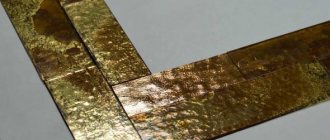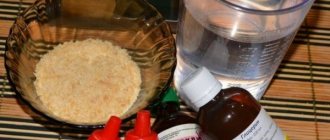To make your own dry ice, bring a carbon dioxide fire extinguisher (labeled OU), a thick cloth bag (or pillowcase), and a cable tie. Be careful. The temperature of the resulting crystals will be about -80 degrees Celsius. Protect your hands, eyes and respiratory system. You can obtain the substance without a fire extinguisher. Use home remedies: baking soda, salt, vinegar or technical sodium acetate (food additive E262).
Pellets should be stored in a special container, a thermos without a lid, a cardboard box or a plastic box. At room temperature, 1 kg of the substance will evaporate in an hour, in the refrigerator - in 3 days. Do not close the lid of the container tightly; it may break. Let the dry ice sit in an open container at room temperature.
Dry ice is used not only in industrial enterprises. With its help, housewives quickly cool food, prepare spectacular “smoke” cocktails, conduct interesting experiments with children, and use it to control pests in their summer cottages. To do this at home, you will need a fire extinguisher or simple available ingredients.
Cooking formula with soda, vinegar, salt
To prepare solid carbon dioxide according to this recipe, you will need to prepare the materials in the correct proportions. Components may not be replaced without permission.
Ratio:
- For 25.25 grams of sodium bicarbonate, use 200 ml of 9% vinegar.
- When using 30% essence, 87.4 g of soda is used.
- At a concentration of 70%, 210 grams of NaHCO3 are used.
- To check the correct ratio of the components, heating is carried out. After waiting for the reaction, a small amount of acid is added. When gas is released with a hissing sound, more acid must be added. Pour gently until the mixture subsides.
- Excess water from the solution is evaporated on the stove. The action is carefully controlled; when the crust forms, the heating stops. The composition is infused for 5 minutes.
- When the crust expands and the solution is tightened with ice, a few drops of boiling water are poured in.
- The mixture is stirred, lumps and ice are removed.
- The resulting thick mass is placed in a glass jar and placed in the refrigerator.
- Cools to a temperature of +15-20 degrees.
- If the instructions are followed correctly, a pinch of table salt is added, which activates crystallization. This produces dry ice.
Expert opinion
Advice!
When crystallization does not occur or is weak, the problem is a lack of acetate. There must be more of it in order for solid carbon dioxide to form. As an alternative, it is recommended to use commercial sodium acetate, available in powder form. The recipe will differ from the instructions described above.
- The crystals are poured into water - take 5 small spoons for 3 of the same spoons of liquid.
- The microwave is set for 10 seconds, if necessary, time is added until the solution becomes clear.
- The grains remaining on the walls of the dish are carefully removed.
- The mixture is placed in the refrigerator until it cools.
- An acetate granule is added to initiate crystallization.
Recommended for you:
Processing and washing an oak barrel with soda: how to do it and why
Bibliography
- Duane, H. D. Roller; Tilorier, M. (1952). "Tiliorier and the first solidification of a 'permanent' gas (1835)". Isis
.
43
(2): 109–113. Doi:10.1086/349402. JSTOR 227174. - Goroll, Allan H.; Malley, Albert G (2009). Primary Medicine: Office Assessment and Management of the Adult Patient
. Lippincott Williams and Wilkins. ISBN 978-0-7817-7513-7 .CS1 maint: ref=harv (communication) - Hering, Heinz-Wolfgang (2008). Processing of industrial gases
. Christine Ahner. Wiley-VCH. ISBN 978-3-527-31685-4. Retrieved 2009-07-31. - Housecroft, Catherine; Sharp, Alan J. (2001). Inorganic chemistry
. Harlow: Prentice Hall. item 410. ISBN 978-0-582-31080-3. Retrieved 2009-07-31. - Keyes, Conrad J. (2006). Recommendations for Cloud Seeding to Increase Precipitation
. American Society of Civil Engineers. ASCE Publications. ISBN 978-0-7844-0819-3.CS1 maint: ref=harv (communication) - Verma, N.K.; Khanna, S.K.; Kapila, B. (2008). Integrated Chemistry for Class XI
. New Delhi: Lakshmi Publications. ISBN 978-81-7008-596-6. Retrieved 2009-07-31.CS1 maint: ref=harv (communication) - McCarthy, Robert E. (1992). Secrets of Hollywood Special Effects
. Boston: Focal Press. ISBN 978-0-240-80108-7 .CS1 maint: ref=harv (communication) - Mithra, Somenath (April 2004). Methods of sample preparation in analytical chemistry
. Wiley-IEEE. ISBN 978-0-471-32845-2. Retrieved 2009-07-31. - Treloar, Roy D. (2003). Encyclopedia of Plumbing
(3rd ed.). Wiley-Blackwell. paragraph 175. ISBN 978-1-4051-0613-9. Retrieved 2009-07-31.CS1 maint: ref=harv (communication) - Yaws, Carl (2001). Matheson Gas Data Book
(7th ed.). McGraw-Hill Professional. ISBN 978-0-07-135854-5. 982 pages. Retrieved 2009-07-27.CS1 maint: ref=harv (communication)
Precautionary measures
Solid carbon dioxide requires careful handling. People follow safety precautions when obtaining useful substances. It is necessary to protect your hands and eyes. The element is capable of affecting the skin and mucous membranes, leaving thermal burns. It is allowed to work with it wearing gloves and safety glasses.
Expert opinion
Attention!
If there is a large amount of ice in a closed space, carbon dioxide poisoning can occur. The element must not be transported in a car with the windows closed, nor placed in a sewer or trash bin.
For disposal, the element is converted into a gaseous state. It is left at room temperature or filled with water. For transportation, it is allowed to use a bucket with air access or a container.
Recommended for you:
How to take soda to increase potency at home
Security measures
Dry ice does not tolerate careless handling.
- First of all, it is necessary to protect your eyes and hands: a seemingly harmless substance can leave thermal burns on the skin and affect sensitive mucous membranes, so you should not approach it without protective glasses and gloves (at worst, a towel).
- In large quantities when in a closed space, ice becomes especially dangerous - inhalation can lead to carbon dioxide poisoning.
- It should not be placed in a portable refrigerator, freezer or other cramped container (expansion occurs during evaporation, which leads to destructive consequences), transported in a car with the windows closed, or thrown into the trash or sewer.
- Food use, as you understand, is strictly prohibited. In case of intoxication (typical symptoms are headache, nausea, vomiting and difficulty breathing), you must urgently seek medical help.
Attention! For disposal, ice is transferred to a gaseous state, left in room conditions or filled with warm water; Proper transportation is in a special container or bucket with access to air.
Making ice with a fire extinguisher
To make dry ice with your own hands, you will need:
- a fire extinguisher containing carbon dioxide (OC marking on the label);
- a cloth bag or thick pillowcase;
- scotch;
- protective equipment (insulated gloves, respirator, goggles).
Carry out the procedure outdoors or in a well-ventilated area
Algorithm of actions:
- Wear gloves and protect your respiratory system and eyes.
- Wrap the pillowcase around the fire extinguisher nozzle and secure with tape.
- Remove the safety pin and press the trigger lever. Hold it in the working position for 3–5 seconds.
- A white haze will begin to seep through the fabric. These are carbon dioxide vapors. They are harmless to humans.
- Press the bag tightly. Remove the fire extinguisher.
- The white, foam-like granules that fill a bag or pillowcase are dry ice. Carefully pour it into the prepared container.
Be careful . The temperature of the substance is -80 degrees. Do not touch it with bare hands; there is a high risk of severe frostbite.
Similarly, you can get frozen pellets from a carbon dioxide cylinder (sold in hardware stores or online).
Check out homemade dishwashing products
Safety precautions when working with dry ice
- The temperature of the substance is minus 78.5 °C, so for work it is necessary to wear heat-insulating gloves. It is prohibited to take ice with bare hands, since even short contact with unprotected skin can cause frostbite.
- When splitting or sawing dioxide into briquettes, it is necessary to use a plexiglass protective mask or strong glasses to avoid getting fragments of the substance on your face.
- When working with the substance, it is necessary to use only dry gloves (mittens), since wet ones instantly freeze and stick to the skin - the risk of frostbite is guaranteed.
- Manipulations using carbon dioxide should be carried out in a room with good ventilation. If people or pets are present, precautions must be tripled.
- It is strictly forbidden to store the substance in tightly closed containers (jars with screw caps, PET containers, etc.). This is extremely dangerous, since during intense evaporation, the dioxide expands 800 times. If the container explodes, it can cause injury to others.
Carbon dioxide, evaporated during the transformation of dioxide, is 1.5 times heavier than air, so it sinks down. At low concentrations the mixture is not explosive. However, in order to avoid force majeure situations, long-term work with this substance should be carried out in the fresh air or in well-ventilated, spacious rooms.
Cooling food with carbon dioxide has a number of significant advantages.
- It is well known that long-term storage of frozen foods reduces their nutritional, taste and energy value. Using quick freezing increases the shelf life by one and a half to two times. Thus, it is possible to reduce food spoilage in catering establishments and at home.
- At large enterprises, employees who were previously engaged in unnecessary work are being released: sorting and sorting products for sale in retail chains or preparing for the production of by-products or finished products.
- The costs previously incurred for running households and subsidiary plots are reduced many times over.
- The use of dry freezing technology made it possible to easily produce large stocks of food products in a varied assortment. Dry ice makes it possible to sell products in hypermarkets and wholesale shopping centers all year round.
- Pre-treatment with dry ice and quick freezing is possible with any products obtained from animals and poultry: meat, meat products, fish and its derivatives, fermented milk and egg products, various fats. Quick freezing is especially effective when processing meat and meat products, since they do not lose their biological and taste characteristics.
- Quick freezing preserves the beneficial properties of products, as well as vitamins and microelements, for a long time. In them, histological, microbiological, physicochemical and biochemical processes that affect the energy and gastronomic value of products and are responsible for their safety are suspended, but preserved.
Dry ice from a fire extinguisher
Initially, to obtain dry ice you will need a fire extinguisher, a thick fabric bag and wire or adhesive tape.
The existing bag must be attached to the base of the fire extinguisher socket so that there are no holes left. To be sure, it is better to seal it with tape or insulating tape. Tightness plays a very important role here. Next, you should carefully remove the fuse from the handle of the fire extinguisher and release several jets of carbon dioxide by pressing the release valve. Thus, carbon dioxide, which is under pressure in the fire extinguisher cylinder, does not have time to cool down and accumulates in the bag in the form of powder or crystals. To prevent it from evaporating, it must be placed in an airtight container or bag and tightly closed.
In the same way, you can get dry ice with your own hands from a carbon dioxide cylinder, which is used for welding work. The cylinder valve should be opened very slowly, since the gas pressure in it is very high. You should be extremely careful not to allow carbon dioxide to come into contact with the skin of your hands and face, as this can cause frostbite.
Safety precautions
Before using a fire extinguisher for your experiments, you should make sure that it is carbon dioxide. There must be a special information marking on its body. The use of other types of fire extinguishers will not achieve the expected results and may be dangerous.
Do not try to get dry ice from gas or air gun cylinders. Opening these objects is extremely dangerous and can lead to unpredictable consequences. When working with a fire extinguisher, it is necessary to use protective glasses and gloves to avoid cold carbon dioxide from contacting mucous membranes.
It is best to purchase a carbon dioxide fire extinguisher from an appropriate store. Then you can be sure that it is completely intact. Dry ice can be obtained from it by periodically refilling it, for example, in a fire department.
Carbon dioxide snow at home
To make carbon dioxide snow at home, you will need the following:
- Liquefied carbon dioxide under pressure.
- Fabric bag.
- Gloves.
- Dry ice storage container.
Carbon dioxide can be taken from a regular household fire extinguisher. It should be marked CO2 or “OU” - carbon dioxide fire extinguisher. Carbon dioxide is also sold in special cylinders.
You can make a fabric bag yourself from woolen clothes. Any other thick fabric will also work.
Gloves are needed to protect against thermal burns, so they must not allow the cold to pass through well.
To directly prepare carbon dioxide snow at home, it is necessary, firstly, to remove the blocking seal from the fire extinguisher (or cylinder). Secondly, it is advisable to put a rubber or polypropylene tube on the fitting, with the help of which the process will be slightly simplified.
How to make soda from dry ice?
If you can buy dry ice, making soda will not be difficult. To do this, you need to stir the syrup in water and add a small cube of dry ice to it. ... To prepare soda you need to take:
- Water - 1 l.;
- Syrup from any berries - to taste
- Dry ice.
2 Dec.
2022 Interesting materials:
How to write sin in Excel? How to record a video conversation on Skype? How to record video from iPhone 12 PRO screen? How to sign up for public services to replace your license? How to pay for the promised payment? How to Fill a Crack in Plastic? How to fill out a cleaning log? How to thread a bobbin into a Pfaff sewing machine? How to refuel Yandex Drive? How to request units on Beeline?
How to store dry ice at home
Both regular ice and dry ice are short-lived if stored at room temperature. The only difference is that dry does not turn into liquid, but evaporates. To preserve this substance for as long as possible, you need to know a few rules.
- The ideal option is to purchase a specialized container. The walls of such containers are multilayered and consist of metal or plastic combined with foam. Dry ice can be stored in such containers for a long time without evaporating.
- If such a container is not found, put the ice in any container made of durable material - cardboard, plastic or metal.
- Do not seal the container tightly! Please note that gas released as a result of evaporation may cause an explosion.
- Glass, porcelain or ceramic dishes are not suitable for storage - they will crack from low temperatures.
- There is no need to put dry ice in the freezer, you risk damaging your equipment.
- You can make a container for storing ice yourself: you will need a cardboard box and polystyrene foam to line its walls. Dry ice should be stored in such a container, covered with a piece of foam plastic.
Extraterrestrial origin
Following the Mars flyby by the Mariner 4 spacecraft in 1966, scientists concluded that the polar ice caps of Mars were composed entirely of dry ice.[37] However, findings in 2003 by researchers at the California Institute of Technology showed that the polar ice caps of Mars consist almost entirely of water ice, with dry ice forming only a thin surface layer that becomes thicker and thinner depending on the season.[37] [38] It has been suggested that the phenomenon, called a dry ice storm, may occur over the polar regions of Mars. They are comparable to terrestrial thunderstorms with crystalline CO.2 taking the place of water in the clouds.[39] Dry ice has also been proposed as a mechanism for Geysers on Mars.[40]
In 2012, the European Space Agency's Venus Express probe discovered a cold layer in Venus's atmosphere where temperatures are close to the triple point of carbon dioxide, and flakes of dry ice are possible to fall out.[41]
Observations of Uranus flyby by Voyager 2 indicate that dry ice is present on the surface of its large moons. Ariel,[42]Umbriel[42] and Titania.[42] Scientists suggest that Uranus' magnetic field promotes the formation of CO.2 ice on the surface of its moons.[43] Voyager 2: Observations of Neptune's moon Triton suggested the presence of dry ice on the surface, although subsequent observations indicate that carbon ice on the surface is carbon monoxide, but the lunar crust consists of significant amounts of dry ice.[44]
Using dry ice
The temperature of dry ice is so low that it is sufficient for making homemade ice cream or other desserts that require refrigeration or quick freezing. It can also be used to cool food and drinks at an outdoor picnic, but contact with moisture should be avoided.
Dry ice in water begins to transform into a gaseous state, which is accompanied by a profuse release of heavy, dense smoke.
Molecular gastronomy using carbon dioxide
In molecular cooking, dry ice is an indispensable assistant in preparing the most delicious dishes and desserts. The main advantage: it is easy to get even for a novice cook - it is ordinary carbon dioxide, frozen in a special way.
Dry ice affects the organs of touch and smell, greatly increasing their sensitivity to the taste and aroma of dishes. In restaurants, molecular gastronomy was one of the first to discover and appreciate the unique properties of this substance, chef from England Heston Blumenthal. While serving guests dishes prepared in his molecular kitchen, the maestro poured the aromatic liquid he invented over the ice. Dispersing across the table along with the gas, exquisite aromas enveloped the guests, allowing them to re-evaluate the taste of previously tried dishes.
Using this technology, the already exquisite dish called “Quail Jelly”, lobster soup-puree, truffles and “Duck Liver Dessert” are transformed. Dishes are served to the table with an oak tray into which fragments of dioxide and oak moss are poured. After certain manipulations, a thick aromatic mist begins to flow. The impressions are truly amazing!
Also, dry ice in molecular gastronomy is used for foaming eggs and fermented milk products (yogurt, cocktails), for carbonating alcoholic and non-alcoholic drinks and even vegetables and fruits. This substance allows you to preserve the freshness of truffles and the beneficial properties of green salads. The unique physical characteristics of dioxide open up enormous prospects and opportunities for creative imagination for culinary specialists!
Let us remind you once again that we have a course on unique techniques for decorating dishes. The course includes a significant amount of molecular gastronomy techniques. The course is suitable for professionals and amateurs; you can familiarize yourself with it by clicking on the link now. We also conduct online master classes on molecular gastronomy; announcements can be viewed here.
Necessary materials
For the experiment, special materials are prepared, sold in a regular store. There will be no problems with the purchase.
List of materials:
- Acetic acid.
- Pan, glass.
- Cotton cloth or paper napkin.
- Glasses or a mask to protect your eyes.
- Household gloves.
- Baking soda.
The list of components varies depending on the selected recipe. Some people make ice using a fire extinguisher, while others use powdered sodium acetate. The set of elements is specified for each option.
Once the materials are purchased, the CO2 manufacturing process begins. It is important to take precautions for a successful procedure.
Let's create magic
- extract acetate
Advice.
If you find acetic acid in the house, it is better to give preference to it - the concentration is several times higher, and accordingly, there is a greater chance that you will succeed on the first try. Baking soda, officially called sodium bicarbonate and sodium bicarbonate, cannot be replaced.
Calculating optimal proportions is a delicate matter; precise electronic scales will come in handy here.
The approximate ratio is:
- For 200 ml of 9 percent vinegar, measure 25.25 g of soda;
- the same amount of 30% essence corresponds to 87.4 g of sodium bicarbonate;
- if the concentration is 70%, there are about 210 g of powder per 200 ml.
You can check whether you have overdone it with soda: mix and slightly heat the ingredients, wait for the reaction to begin and pour in a little more vinegar. If gas is released with hissing, you will have to add more acid - pour a little at a time until the mixture subsides.
- turn acetate into hot ice
- So, you have a saturated solution at your disposal. You can warm it up on the stove or in the microwave, there is no difference, the only important thing is to evaporate the excess water.
- The action must be carefully controlled: as soon as a crust begins to form, heating should be stopped.
- Leave the composition alone for five minutes; Noticing that the crust is expanding and the solution is being covered with ice, pour in a few drops of boiling water.
- Stir, add a little more liquid, repeat until lumps and ice are completely eliminated.
- The resulting thick mass should be placed in a glass jar and put in the refrigerator - let it cool to room temperature.
If everything is done correctly, when you add a pinch of table salt, rapid crystallization will begin, and you will get the desired hot ice.
In the case when the ice is made not from soda and vinegar, but from industrial powdered sodium acetate, proceed as follows:
- Pour the crystals into plain water, at the rate of 5 level teaspoons per 3 teaspoons of liquid, and microwave for 10 seconds.
- Add the same amount of time, check the reaction - heat until the solution becomes crystal clear.
- Any grains that have lingered on the walls of the dish must be carefully removed, or simply pour the solution into a clean container.
- Then everything is as usual - put it in the refrigerator and wait until the temperature drops to at least room temperature.
- To start crystallization, just throw in a granule of dry acetate.
As you can see, you can make the famous dry ice without any special chemical skills.
Artificial snow based on soda.
Something went wrong
- If crystals are noticed in the cooled acetate solution or it has completely frozen, repeat the experiment with the same composition, starting with warming up. Make sure that now the crystals do not linger on the walls of the dish.
- The solution can be used repeatedly, but since its saturation will increase each time due to the evaporation of water, there is a possibility of premature crystallization. To correct the awkward situation, pour in half a teaspoon of water and do everything again, starting with heating.
- It also happens that crystallization does not occur at all or occurs very weakly. The root of the problem is the insufficient volume of acetate: add an incomplete additional spoon of powder, and everything will work as it should.
From sodium acetate
This substance is used in the food industry. It is known as preservative E262.
To make dry ice at home from ready-made sodium acetate:
- Fill 5 tablespoons of granules with 3 tablespoons of water.
- Microwave for 10 seconds.
- Check the reaction. The granules should be completely dissolved and the mixture should be clear.
- If large particles are visible, continue heating.
- Pour the liquid into a clean container. There should be no granules on the walls.
- Place in the refrigerator.
- After cooling to +15°C, carefully dip the dry acetate granules into the liquid substance using tweezers.
Pour the ice into a cardboard box or plastic container. Use as needed.
Method for making ice from a test tube
This option is suitable for people who want to make solid carbon dioxide at home. You will need a fire extinguisher, glasses, acetic acid, and a plastic bag. You will have to carry out some laboratory experiments strictly according to the instructions.
First you need to extract carbon dioxide: mix sodium bicarbonate and table vinegar. For the convenience of collecting gas, a special glass test tube with a gas outlet tube is used. The tip is placed in water.
In this case, rising bubbles of carbon dioxide will begin to fill another test tube, gradually displacing the liquid. To get a significant amount of gas, they will need to fill a plastic bag.
To create ice, specific conditions must be created. It is important to cool carbon dioxide immediately. The package is mounted on a fire extinguisher or on a cylinder, from which two or three jets are released into the package. This will ensure the necessary cooling. Carbon dioxide from the bag will precipitate in the solid phase.
Recommendations
- ^ a b
Yaws 2001, paragraph 125 - Barber, S. R. (March 1966). "The Sublimation Temperature of Carbon Dioxide". British Journal of Applied Physics
.
17
(3):391–397. Doi:10.1088/0508-3443/17/3/312. ISSN 0508-3443. - Mangan, T. P.; Salzmann, C. G.; Plane, J.M.C.; Murray, B.J. (September 2022). "Structure and density of CO2 ice under Martian atmospheric conditions". Icarus
.
294
: 201–208. Doi:10.1016/j.icarus.2017.03.012. - Yaws 2001, paragraph 124
- Khanna and Kapila 2008, paragraph 161 harvnb error: no target: CITEREFKhannaKapila2008 (help)
- Khanna and Kapila 2008, paragraph 163 harvnb error: no target: CITEREFKhannaKapila2008 (help)
- Tilorier (1835). "Carbonic Acid Curing". Comptes Rendus
(In French).
1
: 194–196.
See also: "Hardening of Carbonic Acid", London and Edinburgh Journal of Philosophy
,
8
: 446–447 (1836). - Note:
- In Bulletin des Lois du Royaume de France
(Bulletin of the Laws of the Kingdom of France), 9th series, part ii, no. 92, p.74 (February 1832) lists: “24° M. Tilorier (Adrian-Jean-Pierre) is hired into the postal administration, demoran in Paris, Place Vendôme, no. 21, after he was received on May 16, a certificate of invention in the invention and improvement of a machine for creating gas; ... "(24th Mr. Tilorier (Adrien-Jean-Pierre), working in the post office, residing in Paris, Place Vendôme, No. 21, where was delivered on May 16 last year, at his request, a certificate for a patent for an invention for ten years to improve the gas compression machine;...)
The patent (No. 2896), which was filed on May 16, 1831 and published in 1836, names Adrien-Jean-Pierre Tilorier as an employee of the French "Administration of Postal Service" (i.e., Post Office) in Paris. clearly as the inventor of a machine for compressing gases, which in 1829 was awarded the Montyon Prize of the French Academy of Sciences in mechanics. The patent describes the machine and its characteristics in detail. See: (Ministry of Commerce of France), "Fill a perfect machine with comprimer le gaz,..." (For the improvement of a machine for compressing gas,...), Description des Machines et Procédés consignés dans les brevets d'invention
,
30
: 251–267 ( 1836). - In Bulletin des Lois du Royaume de France
- ^ a b
Killeffer, D.H.
(October 1930). "Growing Industry - Dry Ice". Industrial and engineering chemistry
.
22
(10): 1087. doi:10.1021/ie50250a022. - Brand reporter
. United States Trademark Association. 1930. ISBN 978-1-59888-091-5. - "What is dry ice?" Continental Carbonic Products, Inc. Archived from the original on 2009-07-27. Retrieved 2009-07-26.
- ^ a b
"Carbon dioxide (CO2) Properties, uses, applications: CO2 Gas and liquid carbon dioxide." Universal Industrial Gases, Inc. Retrieved 2009-07-26. - Good Design and Operation of Onshore Carbon Capture Plants and Onshore Pipelines Archived June 24, 2012 Wayback Machine. Energy Institute. London. September 2010. p. 10
- ^ a b
“How does dry ice work?”. How it works. April 2000. Retrieved 2009-07-26. - "Selling Dry Ice - How to Sell Dry Ice." dryiceinfo.com
. Retrieved July 6, 2015. - "Polar® Insulated Container System" (PDF). dacocorp.com
. Retrieved 11 Jan 2022. - ^ a b
"Cool uses of dry ice". Airgas.com. Archived from the original on 2010-12-01. Retrieved 2009-07-25. - "Preparation of competent E. coli with RF1/RF2 solutions". Personal.psu.edu. Retrieved 2009-07-25.
- Blumenthal, Heston (29 October 2006). "How to Make the World's Best Molasses Pie and Ice Cream." Sunday Times
. London. Retrieved 2007-06-12. - "Cleaning Up Oil Spills with Dry Ice and Ingenuity," Gordon Dillow, Los Angeles Times, South Bay Section, Page 1 February 24, 1994
- McCarthy 1992
- Kuntzleman, Thomas S.; Ford, Nathan; No, Jin-Hwan; Ott, Mark E. (April 14, 2015). "A molecular explanation of how fog forms when dry ice is placed in water." Journal of Chemical Education
.
92
(4):643–648. Bibcode:2015JChEd..92..643K. Doi:10.1021/ed400754n. ISSN 0021-9584. - Lyell A. (1966). "Treatment of warts." British Medical Journal
.
2
(5529): 1576–9. doi:10.1136/bmj.2.5529.1576. PMC 1944935. PMID 5926267. - ^ a b
Goroll and Malley 2009, para. 1317 - Treloar 2003, paragraph 528
- Risen WK, Boyce K, Cummings RK, Delgado O, Gutierrez A, Meyer RP, Scott TW. (1999). "Comparative effectiveness of three methods for sampling adult mosquitoes in habitats representing four different California biomes." J Am Mosq Control Assoc
.
15
(1): 24–31. PMID 10342265. - "The city uses dry ice to kill rats." New York Daily News
. - “Can a Freezer Gun Set Ice on Fire,” Zantos Peabody, Los Angeles Times Local Section, B3 9/3/2002
- ^ a b
Horrell, Bill (February 1961).
“Dry ice is cracking off asphalt slabs.” Popular Mechanics
.
115
(2):169. - Mundis, Warren J. (July 1960). "Dry ice as a plumbing solution." Popular Science
.
177
(1):159. - Walcott, John (January 2008). “The ice cleaning company offers a great cleaning method.” The Daily Herald
. Archived from the original on January 9, 2008. Retrieved 2008-01-20. - “Everything about ice - ice carvings, vodka cobblestones, crushed and dry ice.” allaboutice.com
. Archived from the original on July 18, 2015. Retrieved July 6, 2015. - “The design and application of press-fit or shrink-fit sleeves and plain bearings is the realm of engineering.” engineersedge.com
. Retrieved July 6, 2015. - Housecroft 2001, paragraph 410
- ^ a b c d
Keys 2006, paragraph 83 - "MythBusters Episode 57." mythbustersresults.com
. - ^ a b Research shows that the poles of Mars are covered with water ice
. National Geography. February 13, 2003. Retrieved 2009-07-26. - Byrne, S.; Ingersoll, A.P. (February 14, 2003). "A sublimation model of Martian south polar ice". The science
.
299
(5609):1051–3. Bibcode:2003Sci...299.1051B. Doi:10.1126/science.1080148. PMID 12586939. S2CID 7819614. - Dry ice storms could hit the Martian poles, experts say
. National Geography. December 19, 2005. Retrieved 2009-07-26. - J. J. Tsien; WH IP, ed. (2006). "Moon and Planetary Science XXXVII (2006) - Observing a Mysterious Region of Mars from the Mars Orbiter Camera" (PDF). Retrieved September 4, 2009.
- A curious cold layer in the atmosphere of Venus. European Space Agency (1 October 2012).
- ^ a b c
Grundy, W. M.;
Young, L. A.; Spencer, J. R.; Johnson, R.E.; Young, E. F.; Buie, M. V. (October 2006). "Distributions of H2O and CO2 ices on Ariel, Umbriel, Titania and Oberon from IRTF/SpeX observations." Icarus
.
184
(2):543–555. arXiv:0704.1525. Bibcode:2006Icar..184..543G. Doi:10.1016/j.icarus.2006.04.016. S2CID 12105236. - Cartwright, R. J.; Emery, J.P.; Rivkin, A.S.; Trilling, D. E.; Pinilla-Alonso, N. (2015). "Distribution of CO2 ice on the large moons of Uranus and evidence for stratification of the composition of their nearby surfaces." Icarus
.
257
: 428–456. arXiv:1506.04673. Bibcode:2015Icar..257..428C. Doi:10.1016/j.icarus.2015.05.020. ISSN 0019-1035. S2CID 117850580. - Lellouch, E.; de Bergh, C.; Sicardy, B.; Ferron, S.; Käufl, H.-U. (2010). "Detection of CO in Triton's atmosphere and the nature of surface-atmosphere interactions". Astronomy and Astrophysics
.
512
: L8. arXiv:1003.2866. Bibcode:2010 A and A ... 512 l ... 8 l. Doi:10.1051/0004-6361/201014339. ISSN 0004-6361. S2CID 58889896. - Nelson, Lewis (2000). "Carbon dioxide poisoning." Emergency medical care. Archived from the original on 2007-07-18. Retrieved 2009-07-28.
- "Regulation (EC) No. 1272/2008 of the European Parliament." Retrieved 2009-07-31.
- Requirements for the transport of dry ice (IATA PI 954)
. Environmental Resource Center. May 24, 2006. Retrieved 2009-07-31. - “Hazardous Materials Information for Passengers.” faa.gov
. Retrieved 2009-07-26.
Instant recipe
- Take a small saucepan and place it on the gas stove.
- Vinegar is poured into the bottom, NaHCO3 is poured onto the bottom, and the resulting mixture is stirred.
- After achieving homogeneity, pour into a glass and place in the refrigerator for further cooling.
The resulting liquid is called sodium acetate. The proportions of soda and vinegar are the same for a successful recipe.
- A frozen mixture of NaHCO3 and acid is taken out of the refrigerator. In this case, the liquid must freeze completely, otherwise it will not be possible to make ice.
- Taking sodium acetate out of the refrigerator, the experiment immediately begins.
- The mixture is placed on the fire and begins to melt.
Recommended for you:
How and why to wash fruits and vegetables with soda
The liquid must be poured into another container; the container is covered with a napkin to prevent premature hardening.
The remaining sodium acetate is taken into the hand to proceed to the next stage of the experiment.
- The napkin is removed from the vessel, then the person touches the surface of the liquid with his hand.
- After contact with sodium acetate, an amazing transformation into ice will begin.
What is dry ice
In fact, this substance has nothing in common with frozen water, that is, with ordinary ice, except for the ability to maintain low temperatures or cool something. The formula of dry ice is the same as that of carbon dioxide - CO2. In fact, it is a gas that has been transferred to a solid state of aggregation, bypassing the liquid phase.
We encounter this chemical compound every day. It is contained in exhaled air. When buying sparkling water or a drink in a store, you have often seen how bubbles of carbon dioxide rush out when you open the bottle.
A large amount of it is released with transport exhaust gases and is contained in the surrounding air. Due to its ability to suppress combustion processes, it is used in the production of fire extinguishers for household and industrial use. Carbon dioxide is used by plants to carry out the process of photosynthesis. But isolating it from the environment is a very labor-intensive and costly process.
Dry ice and its characteristics
We are all accustomed to considering ice as one of the forms of water, which it takes at low temperatures. However, the substance that is commonly known as dry ice has nothing to do with frozen water. What is this substance, which is used in a wide variety of industrial and domestic fields?
This substance is nothing more than carbon dioxide in the solid state. The formula of dry ice is completely identical to the formula of carbon dioxide CO2, and at normal temperatures the substance instantly turns into vapor, without delay in the liquid phase.
Dry ice is a solid substance whose structure resembles the familiar ice that everyone is familiar with, which is why it was called that. Its peculiarity is that this substance goes from a dry state directly to a gaseous state, bypassing the formation of a liquid. In its composition, it consists entirely of carbon dioxide, which is cooled to a very low temperature - minus 78 degrees. For humans, it is a safe and environmentally friendly substance.
Outwardly, it is no different from its water counterpart. Same white color, same cooling ability, no odor and safety for humans. However, the basic physical properties still differ from the properties of ordinary frozen water.
You can start with the fact that a piece of this substance cannot be held in your hands for a long time. Cooled carbon dioxide has a huge reserve of low temperature, which will not allow a person without special protection to withstand prolonged contact with its solid form. When using it, you must take into account safety rules. It is necessary to avoid getting its small pieces into your eyes; if you are going to pick it up, it is better to remove all metal jewelry from them.
Dry ice can be made both at home and using production equipment. Making ice at home is quite dangerous, labor-intensive and not very profitable. You can do this only for the sake of an interesting experience. In addition, dry ice, which was produced in artisanal conditions, is more reminiscent of dry snow and is of low quality.
The quality of the ice produced in production complies with GOST standards; it can be purchased in any quantity and at any time, for example, at JSC “Dry Ice”.
The use of such material is quite diverse and in some cases is limited by the imagination of the consumer himself. It can be used both in production and extensive activities, as well as in everyday life; both for serious matters and for entertainment.
Here are the main uses:
- food preservation and freezing. In this case, we can talk about large volumes of food, and an ordinary refrigerator bag, which is usually used for a picnic. To preserve food, dry ice is first poured in and food is placed on top. They can remain in this state for about a week. This is how milk was kept fresh at Soviet dairy collection points;
- transportation of organs and tissues in the medical field, as well as preservation of biological materials;
- creating visual effects. Using dry ice, a fog is created that slowly creeps along the ground;
- extinguishing fires;
- soda water;
- protection against mosquitoes and midges. If you pour a pile of dry ice far from a place of recreation in nature, insects will flock to it;
- conducting interesting experiments.
It is with the help of small scientific tricks that you can interest a child in chemistry, physics, etc. For example, you can show “singing metal” or fog in bubbles when a soap solution is added to water with dry ice.
Area of use
The characteristics of dry ice are used everywhere where it is necessary to maintain a certain low temperature regime. For example, due to the ability of a substance to release a huge amount of cold when turning into steam, it is actively used for the so-called “shock” freezing of food. At the same time, all their beneficial properties are perfectly preserved, and the structure remains the same.
Dry ice is also used to cool refrigerators and tanks in which products with a limited shelf life are transported. A mixture of dry and regular ice is indispensable for normal cooling of various foods or drinks.
Thanks to its unusual properties, frozen carbon dioxide has gained wide popularity in everyday life. It is interesting to observe the effect that dry ice produces when in contact with other substances, such as ordinary water. The calm surface of the water will begin to boil, as if boiling, if even a small piece of dry ice gets there. This property is actively used in cooking, in particular when creating cocktails.
Thanks to this substance, serving the most ordinary drink can turn into a real show, as professional bartenders know very well. They regularly use the dry ice trick to create little masterpieces.
Soda lovers should buy dry ice - and their favorite drink will always be cold and at hand. It is enough to throw one piece of cold substance, for example, into a container of juice, and shake well. The result will be a classic soda bursting with numerous bubbles. During this procedure, the ice dissolves without a trace, leaving behind neither taste nor smell.
Dry ice is often used at various parties, concerts and shows to create a spectacular smoke screen. Artificial smoke is formed as a result of the interaction of pieces of dry ice and ordinary water.
In medicine
Thanks to the capabilities of carbon dioxide, it has become possible to transport organs for transplantation, donated blood and test samples over long distances. Now this saves many lives, so the role of dry ice in medicine is simply invaluable.
In the food industry
When producing meat and fish preparations, dry ice is added to the minced meat to quickly cool the mass, which contributes to its better preservation. Dry ice is also used when transporting perishable food products. Its temperature of -79°C can cool quickly and maintain the desired temperature for a long time.
On holidays
The service industry is constantly developing, innovations and technical innovations are actively used to make the holiday more colorful and fun. Dry ice is an indispensable assistant when organizing a wedding, birthday, or corporate event. This substance not only helps keep drinks and desserts cold even in the hottest heat, but also helps create various visual tricks and special effects. A show using dry ice will be remembered for a long time by the guests of the event, because the natural evaporation of dry ice will create a feeling of some mystery. Therefore, the organizers of the celebration try to buy dry ice in advance and plan the festive show.
Design of pyramids from glasses of champagne
A pyramid of glasses with champagne can decorate a special event: a wedding, presentation, conference, exhibition, etc. Sparkling wine sparkles in the rays of light, and the rising bubbles only enhance the pleasant sensations of what you see. The use of dry ice adds a special twist to the pyramid of glasses with sparkling wine.
This substance allows you to achieve several effects at once:
- the drink will remain cold for a long time, as champagne should be before drinking;
- natural evaporation will create a light haze for some time, which will add charm and mystery to the event;
- the illusion of bubbling champagne appears due to the evaporation of dry ice, although in fact the drink is in a completely natural and calm state;
- the taste of champagne will remain unchanged, because unlike regular ice, dry ice will not change the consistency of the drink at all.
When ice melts, no water is released, which will dilute the taste of champagne. If you add professional illumination to the pyramid of champagne glasses, then this event will be remembered by the guests of the holiday for a long time. A haze of dry ice, illuminated from different sides with different colors, will create a truly magical effect.
Organizers of outdoor festive ceremonies will deliver glasses, champagne and decorations to the location specified by the client. The construction of the pyramid is carried out in 1.5-2 hours, the drink remains cold for several hours. Fruits, cocktail cherries, rose petals, etc. can be added to the sparkling drink. All this will give the pyramid additional charm, attractiveness and unusualness. A creative approach is used in the design of the pyramid of champagne glasses, which will make it purely individual and consistent with the general theme of the holiday.
In entertainment activities
How can dry ice help entertainment venues entertain their patrons beyond cooling a variety of cocktails? It turns out that it’s not all about the cocktails. This substance is used to create gorgeous special effects in the form of smoke screens. The fog spreading across the floor together with light rays of different colors creates a suitable atmosphere for discos and concerts.
Where can I buy
Where to buy dry ice, you can get the answer to this question by calling the company that produces and sells this product. Our company sells solid carbon dioxide with high refrigeration capacity. Our products meet all criteria and standards of GOST.
Here you can buy any batch of dry ice, ordering it even at night. The 24-hour operation of the enterprise ensures its availability constantly and at a very favorable price for customers.
In what form and where can I buy it?
You can buy this substance in the chemical department and even in online stores. Manufacturing companies sell granulated ice to organizations in large thermal containers with a volume of 250-350 liters.
In retail, this substance is sold in containers of 1-25 kg or more. You can store ice at home in store-bought Styrofoam packaging for up to 3 days. To extend shelf life, you can use an isothermal container.
You may be interested in: Applications that rid Android of unnecessary junk
There is also dry snow on the market, this is the same substance, but only in the form of flakes. The packaging indicates under what conditions and in what quantity the ice is stored.
From soda and vinegar
The cooking method is similar to the previous one:
- Combine baking soda and acetic acid (1:1). There should be no reaction (formation of foam).
- Heat the mixture until the liquid has evaporated and a thick crust begins to form on the surface.
- Cool to room temperature. Do not stir. In 15–20 minutes you will get a monolithic piece of sodium crystalline hydrate.
- The liquid remaining after “freezing” is sodium acetate. Drain it into a separate container.
- Melt the re-crystallized substance. Pour into a clean bowl, cover with a napkin, and cool.
- Drop some of the previously drained sodium acetate. The liquid will freeze instantly.
The solution can be used repeatedly.
For disposal, leave the substance at room temperature. Do not pour waste into the sewer; wait until the substance evaporates naturally.
Find out how to dilute vinegar to the desired concentration
Why do you need a fire extinguisher?
Anyone wondering how to make dry ice should be aware that the process is not safe. You should prepare for it carefully.
First of all, you will need a fire extinguisher. No, there will be no fire, but nevertheless this is one of the main components. Otherwise the experiment will not work. If someone is interested in how to make dry ice without a fire extinguisher, then this is only possible in an industrial environment using a special installation. But for home experiments, an expensive installation is not suitable.
How to make dry ice? To make it yourself you will need a large amount of carbon dioxide. Simply breathing into a bag, relying on the capacity of your lungs, is not enough. That's why a fire extinguisher is required.
There is a large amount of carbon dioxide inside the fire extinguisher, which hardens when exposed to air. When using it, white foam flies out, which is absolutely safe. It does not contain impurities or toxins and does not smell of anything. It is this dioxide that is needed for the experiment.
Areas of use
Dry ice has a wide range of applications:
- In industry. It is used to clean equipment. Ice removes any dirt without additional cleaning agents.
- In the transport industry. It is used for cleaning housings, generators, engines and other machine components. It copes with dirt in the most inaccessible areas where other means cannot be used.
- In animal husbandry. Carbon dioxide is used to brand livestock.
- In food production. It is used to maintain low temperatures, clean equipment, and prepare carbonated drinks.
- In construction. The impact of ice helps to quickly cope with the dismantling of tiles, and is also used for other operations.
- In gardening. With its help, they get rid of pests on the site.
- In the entertainment industry. The gas that is formed when the substance is heated is used to produce special effects.
This is not a complete list of ways to use frozen carbon dioxide. If you make dry ice at home, you can replace household chemicals with it.
What is the essence of the experience and what you will need
Initially, dry ice has a gaseous state; its formula CO2 is familiar to everyone from a chemistry course.
During the experiment, carbon dioxide hardens, and for this it does not have to turn into liquid and then solidify.
By contacting with water, acetate forms a crystalline hydrate, that is, 1 molecule of salt combines with 3 molecules of water; upon reaching a temperature of 90 degrees, it actively melts.
Sodium acetate, also known as sodium acetate, is a crystalline powder. It is not necessary to buy this reagent - at home, its analogue is produced independently, from baking soda and ordinary vinegar.
Characteristics
For additional chemical data, see Carbon Dioxide Data.
Dry ice is the solid form of carbon dioxide (CO2), a molecule consisting of one carbon atom bonded to two oxygen atoms. Dry ice is colorless, nonflammable, with a sour, pungent odor and can reduce solution when dissolved in water, forming carbonic acid (CA2CO3).[1]
Comparison of phase diagrams of carbon dioxide (red) and water (blue) as a logarithmic diagram with phase transition points at 1 atmosphere
At pressures below 5.13 ATM and temperatures below -56.4 °C (-69.5 °F) (triple point), CO2 changes from a solid to a gas without an intermediate liquid form through a process called sublimation.[note 1] The opposite process is called deposition, where CO2 changes from gas to solid phase (dry ice). At atmospheric pressure, sublimation/deposition occurs at -78.5 °C (-109.3 °F) or 194.7 K.[2]
The density of dry ice increases with decreasing temperature and ranges from 1.55 to 1.7 g/cm3 (97 and 106 lb/cu ft) at -193.2 to -78.1 °C (-315. 8 to -108.6 °F) or 80 to 195 K.[3] The low temperature and direct sublimation into gas make dry ice an effective coolant, as it is cooler than ice water and leaves no residue when it changes state.[4] Its enthalpy of sublimation is 571 kJ/kg (25.2 kJ/mol).
Dry ice is non-polar, with a dipole moment of zero, so the attractive intermolecular van der Waals force works.[5] The composition results in low thermal and electrical conductivity.[6]
Warnings
- Conduct experiments only in a well-ventilated room. Carbon dioxide, turning into gas, displaces oxygen in the air.
- If you are a child, carry out such experiments only under adult supervision, and wear thick gloves when in contact with ice.
- When storing dry ice, do not cover it with a lid. The gas produced by evaporation must be dispersed into the air, otherwise it may rupture the closed container.
- Avoid direct skin contact with ice. You may get severe frostbite.











